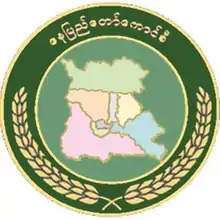Naypyidaw Union Territory
Naypyitaw Union Territory (Burmese: နေပြည်တော် ပြည်တောင်စုနယ်မြေ; also spelled Nay Pyi Taw) is an administrative division in central Myanmar (Burma).[2] It contains Naypyidaw, the capital city of Myanmar.
Naypyitaw Union Territory
နေပြည်တော် ပြည်တောင်စုနယ်မြေ | |
|---|---|
 Flag  Seal | |
 Location in Myanmar (Burma) | |
| Coordinates: 19°45′0″N 96°6′0″E | |
| Country | |
| Capital | Naypyidaw |
| Government | |
| • President of Myanmar | Win Myint |
| • Mayor and Chairperson of the Naypyidaw Council | Myo Aung |
| Area | |
| • Total | 7,054 km2 (2,724 sq mi) |
| Population | |
| • Total | 1,160,242 |
| • Rank | 13th |
| • Density | 160/km2 (430/sq mi) |
| Demonym(s) | Naypyidawan |
| Time zone | UTC+6:30 (MMT) |
| Area code(s) | 2 (mobile: 69, 90) |
| Website | www |
| Administrative divisions of Myanmar |
|---|
| First-level |
|
| Second-level |
| Third-level |
| Fourth-level |
| Fifth-level |
Administrative divisions
The Naypyidaw Union Territory consists of the following districts and townships:
- Ottara District (also known as North Naypyidaw)
- Ottarathiri Township (ဥတ္တရသီရိမြို့နယ်)
- Pobbathiri Township (ပုဗ္ဗသီရိမြို့နယ်)
- Tatkone Township (တပ်ကုန်းမြို့နယ်)
- Zeyathiri Township (ဇေယျာသီရိမြို့နယ်)
- Dekkhina District (also known as South Naypyidaw)
- Dekkhinathiri Township (ဒက္ခိဏသီရိမြို့နယ်)
- Lewe Township (လယ်ဝေးမြို့နယ်)
- Pyinmana Township (ပျဉ်းမနားမြို့နယ်)
- Zabuthiri Township (ဇမ္ဗူသီရိမြို့နယ်)
Administration
Naypyidaw Union Territory is under the direct administration of the President. Day-to-day functions are carried out on the President's behalf by the Naypyidaw Council led by a Chairperson. The Chairperson and members of the Naypyidaw Council are appointed by the President and include both civilians and Armed Forces representatives.[3]
On 30 March 2011, President Thein Sein appointed Thein Nyunt as chairman of the Naypyidaw Council, along with 9 chair members: Than Htay, Colonel Myint Aung Than, Kan Chun, Paing Soe, Saw Hla, Myint Swe, Myint Shwe and Myo Nyunt.[4]
Demographics
| Year | Pop. | ±% |
|---|---|---|
| 2014 | 1,160,242 | — |
| Source: 2014 Myanmar Census | ||
The 2014 Myanmar Census reported that Naypyidaw Union Territory had a population of 1,160,242.[5] The population density was 164.4 people per km².[5] The census reported that the median age was 26.8 years, and 95 males per 100 females.[5] There were 262,253 households; the mean household size was 4.1.[5]
Religion
According to the 2014 Myanmar Census, Buddhists make up 96.8% of Naypyidaw Union Territory’s population, forming the largest religious community there.[6] Minority religious communities include Christians (1.1%), Muslims (2.1%), and Hindus (0%) who collectively comprise the remainder of Naypyidaw Union Territory’s population.[6]
According to the State Sangha Maha Nayaka Committee’s 2016 statistics, 10,956 Buddhist monks were registered in Naypyidaw Union Territory, comprising 2% of Myanmar's total Sangha membership, which includes both novice samanera and fully-ordained bhikkhu.[7] The majority of monks belong to the Thudhamma Nikaya (98.2%), followed by Shwegyin Nikaya (1.8%), with the remainder of monks belonging to other small monastic orders.[7] 923 thilashin were registered in Naypyidaw Union Territory, comprising 1.5% of Myanmar’s total thilashin community.[7]
References
- Census Report. The 2014 Myanmar Population and Housing Census. 2. Naypyitaw: Ministry of Immigration and Population. May 2015. p. 17.
- Archived November 16, 2010, at the Wayback Machine
- "Constitution of the Republic of the Union of Myanmar" (PDF). Upload.wikimedia.org. Retrieved 13 October 2014.
- Thein Sein (31 March 2011). "Notification No. 7/2011: Formation of Nay Pyi Taw Council" (PDF). New Light of Myanmar. p. 15. Retrieved 21 August 2011.
- "Nay Pyi Taw Union Territory Report" (PDF). 2014 Myanmar Population and Housing Census. May 2015.
- The 2014 Myanmar Population and Housing Census Census Report Volume 2-C (PDF). Department of Population Ministry of Labour, Immigration and Population. July 2016. pp. 12–15.
- "The Account of Wazo Monks and Nuns in 1377 (2016 year)". State Sangha Maha Nayaka Committee. 2016. Retrieved 2021-01-19.